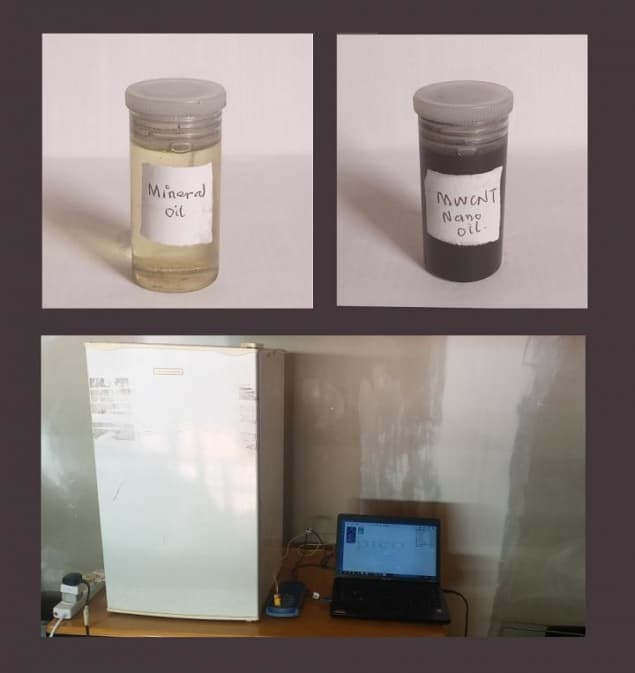
Adding multi-walled carbon nanotubes (MWCNTs) to a common refrigerant can reduce a domestic refrigerator’s power consumption by nearly 30%, according to researchers at the University of Johannesburg in South Africa. Such a huge energy saving would be particularly welcome in low-income countries where electricity blackouts are frequent and refrigerators often have to run off expensive generators.
A conventional refrigerator works by pumping a refrigerant around a closed system. The refrigerant expands from a liquid to a gas, and then contracts to become a liquid again – a process that requires electrical energy, which is acquired by cooling the surroundings on the cold side of the system. This heat is then released on the hot side when the gas condenses back into a liquid.
Many domestic, and indeed industrial, refrigerators use a chemical called R134a as their refrigerant. Also known as tetrafluoroethene, R134a has the chemical formula CF3CH2F and belongs to the hydrofluorocarbon family of refrigerants. Although it is non-flammable and boasts a low ozone depleting potential (ODP) compared to chlorofluorocarbons and hydrochlorofluorocarbons (both of which were phased out in the 1990s), it does have a high global warming potential (GWP). For this reason, other refrigerants are being sought to replace it.
Replacing R134a with a R600a/MWCNT mix
In this work, researchers led by Daniel Madyira studied an alternative refrigerant called R600a, or isobutane. This chemical has a low GWP as well as a low ODP and is starting to replace R134a in new refrigeration units, especially domestic and light commercial systems such as fridges, freezers and drink dispensers.
To improve the cooling efficiency of their R600a, the researchers dosed it with 0.4 g/L to 0.6 g/L MWCNTs in a mineral oil lubricant. They then removed R134a and its compressor oil from a household refrigerator (which was manufactured to work with 100 g of R134a) and fed their new R600a/MWCNT mix into the inlet of the fridge’s compressor.
Performance tests by the University of Johannesburg team revealed that the fridge cooled faster when running on R600a/MWCNTs and had a reduced evaporation temperature of –11 °C after 150 minutes. “This is lower than the –8 °C for R134a,” Madyira explains. “It also exceeds the ISO 8187 standard, which calls for –3 °C at 180 minutes.”
29% less energy consumption
The Johannesburg team found that their modified appliance consumed 29% less energy than one using R134a – a figure that Madyira calls “a significant energy gain for users, especially low-income households”. He adds that both the reduction in energy consumption and the resulting improvement in cooling performance are due to the nanoparticles, which “not only improve the refrigerant’s thermal conductivity but also reduce friction and wear on the fridge’s vapour compressor,” he tells Physics World. The reduction in friction, in turn, enhances the heat transfer rate and reduces the pumping power required by the compressor for effective operation. Previous work by other groups also showed reduced energy use when refrigerants made with water or ethylene glycol were dosed with MWCNT particles in a similar fashion.
Don’t try this at home
Despite the potential boost to cooling efficiency, Madyira advises against simply replacing the refrigerant in your fridge with R600a. Instead, a trained refrigeration technician should do the job – not least because R600a, unlike R134a, is flammable. Also, while some refrigerator manufacturers have begun to commercialize appliances that use R600a, they use no more than 150 g of the material in a domestic fridge. In their work, Madyira and colleagues used between 50–70 g to stay within safety parameters.

‘Colossal elastocaloric effect’ could lead to better refrigerators
Another barrier to do-it-yourself replacement is that the mineral oil used in the compressor needs to be mixed in the right concentrations, with a magnetic stirrer or sonic bath used to agitate and homogenize the ingredients before adding them to the compressor. The main challenge in this step, Madyira explains, is to overcome coagulation of the particles before adding the oil to the compressor – a task that requires careful preparation.
The researchers, who describe their work in Energy Reports, say they will now test different types of nanoparticles to determine whether they reduce power consumption in vapour compression refrigeration systems. “We will be continuing to conduct tests on various other types of refrigerants to see if the same performance benefits reported for R600a can be duplicated,” says Madyira. “We also need to further analyse the durability of the nanoparticles we tested.”



